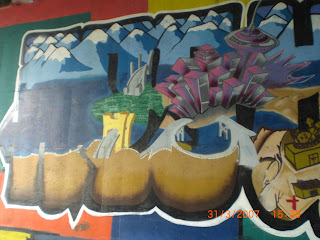Graffiti has become a worldwide trend, which is steadily increasing in popularity. We can see that this is growing tendency occurring in the region of Greater Vancouver. Graffiti has been linked to individual or group/gang related forms of expression. The world of graffiti has been looked upon through several negative connotations due to the marking or painting of property – usually without the owners consent. One of the most popular sites that one can see graffiti is on the way to Granville Island, on the south foot of Anderson Street at West 4th Avenue, there is a mural where several graffiti artist go to present their skills. Through several experiences on my way to Granville Island, I have gone passed these murals and have been astonished at the work of those certain individuals. Last week there were two different illustrations of Graffiti art (see this below). Both of these pieces were very different however, shared one great similarity, they both had some reference to Vancouver culture. Through the pictures I have demonstrated and the idea of graffiti, I would like to concentrate on the theme of creative expression.
Interestingly, both of the illustrations were ‘tagged’ demonstrating the members of the graffitists. “This graffiti style uses a signature or logo (sometimes stylized and called a ‘tag’) that is unique to an individual graffiti writer or ‘taggers,’ experienced graffitist within the subculture could identify and credit work. “ (Powers, Lynn. pg 137) The first graffiti is a ‘Haidagwaii’ design in which it is portraying a raven. (://vancouver.ca/engsvcs/streets/graffiti/ ) This is a common native aboriginal animal and is seen throughout aboriginal culture. The second graffiti is a located on the other side of the mural and it is an illustration of Greater Vancouver- highlighting certain characteristics of Vancouver. (Displayed in the picture is, downtown Vancouver, the mountains and water surrounding the city, Granville islands- including Emily Carr, steam works and more, and the major bridges in the city including the Lion Gate Bridge)
Two of these pieces were designed in a way to demonstrate their artistry, an expression to their imagination and voice within their graffiti. This can be seen as a form of collective conscious portraying a several messages in reflection of the artist works. “What we call expressive graffiti, then, may not be a direct reflection of the dominant community value-system at all,” (Gonos, George.pg 42) but an expressive form of creativity on the individual’s behalf. There can be many understandings from the portrayal of the work of graffiti. The anonymity of graffiti allows one to become part of today’s mainstream pop-culture, however, in addressing their values, beliefs, concerns etc. “The anonymity afforded the graffitist allows the opportunity to use language, and present beliefs and sentiments, which are not acceptable in ordinary life.” (Gonos, George.pg 42) This grants graffiti artists a place or a sense of niche that provides freedom within their own society, enabling artist to freely express their creativity and message through their illustrations.
The representation of graffiti can be in a sense looked upon like a statement of what one is attempting to communicate. After looking into the graffiti world in Vancouver, I came across a Georgia Straight article indicating that this mural was part of ‘The Restart Program.’ This program was to allow graffiti artists to create a large-scale mural in public areas but expressing themselves without vandalizing private property. (http://www.straight.com/article-324713/vancouver/graffiti-gone-wild?page=0%2C0) ‘The Restart Program,’ originated for kids with bad vandalism records, it gave graffitists a second chance of expression through the guidance and management of a public art programmer. Such programs are funded by the City of Vancouver, promoting the self-expression that is felt through graffiti but keeping them out of future punishable crimes. “We can build a relationship with these youths, build trust with them, give them an opportunity to share their experiences, share their perspectives on graffiti, to speak openly in a safe environment,” Copeland said, “and then, at the same time, hear the perspectives of other people in their community.” (Same site as above) Other examples of the ‘The Restart Program,’ are seen on Beatty Street, which have painted over anti-Olympic slogans. This form of ‘tagging’ that are demonstrated through these graffiti artist (through the picture above) represent their positive transformation of anti-vandalism, yet, still illustrating their love for graffiti. This form of pop-culture has generated a wide range of new artist to maintain this trend. Putting forth their collective experience and ideology through the art of graffiti is their own creative form of expression.
Sources:
Brown, W. K. "Graffiti, Identity and the Delinquent Gang." International Journal of Offender Therapy and Comparative Criminology 22.1 (1978): 46-48. NCJRS Abstract-National Criminal Justice Reference. NCJRS. Web. <http://www.ncjrs.gov/App/Publications/abstract.aspx?ID=149159>.
Gonos, George, Virginia Mulkern, and Nicholas Poushinsky. "Anonymous Expression: A Structural View of Graffiti." The Journal of American Folklore Society 89 (1976): 40-48. JSTOR: American Folklore Society. JSTOR. Web. <http://www.jstor.org/pss/539545>.
Lachmann, Richard. "Graffiti as Career and Ideology." American Journal of Sociology 94.2 (1988): 229-50. American Journal of Sociology. JSTOR. Web. <http://www.jstor.org/stable/2780774>.








